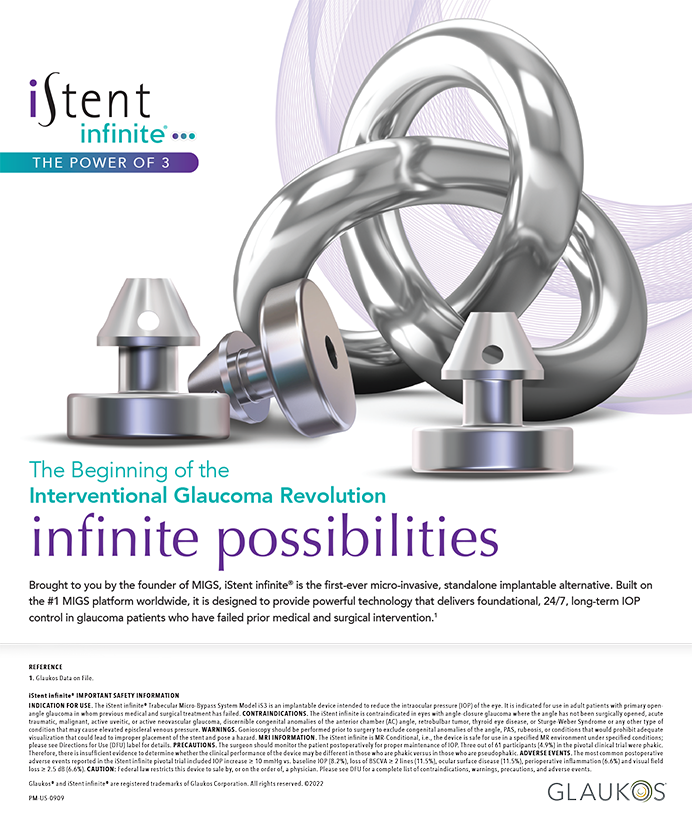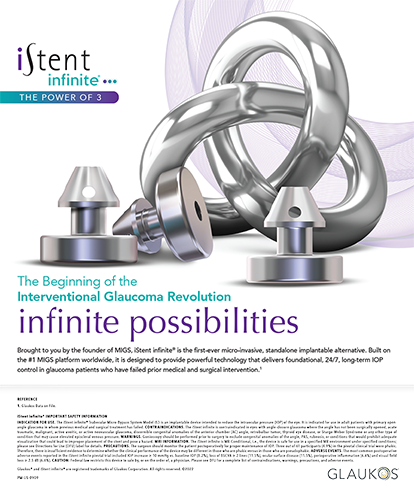NOTES FROM A LARGE PRACTICE
By Stephen M. Weinstock, MD
The Eye Institute of West Florida transitioned to electronic health records (EHRs) in 2011. Many of our associates had shared their conversion nightmares, so we delayed as long as we could without missing governmental incentives. Anticipating the necessity of the move, we researched various software programs over several years. Experiences shared by members of the American Society of Ophthalmic Administrators were invaluable. We talked to and visited other practices, and we carefully analyzed how the right software could best meet our patient-flow and practice patterns.
Based on the information we gathered (including vendors' reputations for service response time), we narrowed our search to eight companies. Of these, we invited five companies to the practice to give 2-day demonstrations, which included physicians and members of every department. Finally, our top three choices were then re-vetted through our interview and demonstration processes. We met with the companies' CEOs, COOs, and sales and training personnel. After much consternation and negotiation, we signed a contract at the American Academy of Ophthalmology Annual Meeting.
We were relieved to complete the process and ready to celebrate. We thought the hard part was behind us. It was not!
CRASH
Our administrator and CEO began a dialogue with our software company regarding the conversion of data from our existing practice management system, software installation dates, and staff training. The first consideration was how and where we were hosting their software. We asked them for recommendations, but they were very reluctant to assist in the selection, because they did not want to be held accountable if it did not work out.
We had to tackle multiple issues related to hosting, servers, and backups that depended on our practice's size, our tolerance for risk, and cost. Once again, we researched the available options and tried to make an informed decision. Although we talked to many different practices, we were unable to find a single one whose experience had been good enough to recommend a course of action, let alone come to a consensus on how to proceed. Our aim was to have the least risk of downtime at the most practical cost. Ultimately, we chose a cloud-based solution that was compatible with our software company's product, although the latter sent a letter stating that they would not be responsible if the software did not perform properly due to our hosting company's configuration.
Despite all this effort, time, and expense and despite our hosting company's assurances to the contrary, once the software was live, our system went down more than once. Our connection to the software was interrupted on a daily basis for the first 6 months. Our hosting company had to have its information technology people onsite for months at a time at greater and greater expense. We were told that the problem was our hardware, device integration, and/or our building structure. We were told that, if we bought one more piece of equipment or paid for additional services, the glitch would be fixed—all to no avail. Our frustration level was so high that we were ready to ditch it all, go back to paper, and suffer the penalties when they came.
Through difficult firsthand experience, we discovered that what we needed most was an expert to help us identify and solve the many integration incompatibilities and inadequacies that existed in the networking setup of our software, hardware, hosting servers, Internet provider, and diagnostic equipment. After much turmoil, we found several professionals, each with a different area of expertise on the architecture of the infrastructure needed to eventually drag us through the quagmire. This was finally accomplished at great cost (well into 6 figures) through the purchases, reconfiguration, and integration of server hosting, necessary redundancy, Internet connections, firewalls, HIPAA-compliant (Health Insurance Portability and Accountability Act) encryption, virtual private networks, bandwidth, routers, monitors, and much more. We went from a hosted solution to a data center facility to—at last—a client server in our own facility.
LESSONS LEARNED
Once our practice's systems were finally up and running, I could not understand the lack of a company to advise us on all the intricacies from the beginning. I wondered if the wheel had to be reinvented every time a practice transitioned to EHRs. In the current marketplace, most EHR vendors have similarly capable software. The decision on which is best suited to a particular practice boils down to individual preferences regarding customizability, ease of use, billing, cost, type of hosting, etc. Once the choice is made, however, why should the transition be so difficult? Why is dissatisfaction so high that roughly 70% of all EHR sales are now to practices switching or “jumping” from one EHR company to another?
The expensive, hard-won truth we found is that the problem does not lie within the EHR software, the hardware, or the hosting solutions. Those vendors do not control the integration processes that ensure a successful implementation. They are experts on their specific products, not on optimizing how those products all work together. Vendors are not knowledgeable about the tools required for a practice's specific preferences on data safety, redundancy, encryption, or bandwidth that will make integration seamless. In particular, we discovered a disconnect between vendors when it came to incorporating all of our different diagnostic equipment's output into a useful clinical format and to dealing with HIPAA compliance and what that entails.
Of course, software vendors are HIPAA compliant, but that does not mean a practice's handling of patients' information is (consider the $1 billion class action lawsuit against Sutter Health1). This is not a software company's responsibility. A practice must ensure that it is compliant in numerous ways. This unanticipated minefield is another reason to hire a savvy consultant to make sure the practice is up, able to work, and protected at all times.
CONCLUSION
In hindsight, we would probably have purchased the same EHR system, but we should have been a thousand times more aware of the integration skills needed to run it properly. Without the help of consultants with information technology “infraware” expertise, I doubt any software would have worked. Had we been better prepared, our ability to provide patients with care would not have been hindered, and our total experience would have been far better. Our costs would also have been 75% lower.
1. Sutter Health faces $1 billion class action suit. TeamShatter website. November 23, 2011. http://www.teamshatter.com/topics/industry/health-care/sutter-health-faces-1-billion-class-action-suit. Accessed February 12, 2015.
Stephen M. Weinstock, MD
• founder and president, The Eye Institute of West Florida, Largo, Florida
• (727) 560-8802; smweye@gmail.com; Twitter @EyeInstituteWFl
NOTES FROM A SMALL PRACTICE
By Timothy D. McGarity, MD
Altogether, my practice consists of 11 employees, including one OD who works 30 hours per week, five technicians, and four administrative staff members. I am the only MD. The focus of the practice is on cataract and refractive surgery.
I would argue that every type of industry other than medicine has already moved to some form of electronic record standard. For me, two positives of adopting electronic health records (EHRs) are becoming more technologically savvy and bringing my practice up to the 21st century.
My practice has had an EHR system in place for 4 months. Already, I believe the technology has improved our level of organization, and we are almost back to full speed. The selection process took about 16 months and was relatively straightforward. Implementation was much more difficult.
CLOUD OR SERVER?
During the selection process, one question was whether we would use a cloud- or server-based system. Ultimately, we chose the former, mainly because I wanted information to be available wherever I am. I spend most of my time at our main clinic, but I travel to two satellite locations to see patients and perform surgery. I did not want to set up really expensive communication lines between the different sites. Moreover, if there is a natural disaster, I have a backup source, and with an EHR system, I do not have to worry about transporting paper charts from location to location.
SNAGS WITH STAFF
Implementing the EHR system took at least 6 weeks. I think that the transition would have been much smoother if my technicians, in particular, were more computer savvy. It is difficult to train someone who does not regularly work on a computer to use an EHR system.
Most important to overcoming this obstacle was my keeping a cool head. I also spent a lot of time after hours organizing protocols for them to follow. I created three or four checklists. In the morning, before clinic started, I would review each item on the checklists with the staff and emphasize the importance of organization and completing each item. I found that this approach really helped my staff to see the big picture as well as how to enter information and how to document a patient encounter.
I had anticipated the difficulty my technicians would have learning to use the computer. What surprised me was the tension I felt during the process. My technicians, too, were anxious. They worried about the initial challenge of seeing patients and entering information in a timely fashion, all while maintaining a high level of care.
TROUBLE WITH INTEGRATION
My practice purchased a separate practice management system that the EHR vendor said would be compatible with its system. I was therefore surprised by a few glitches in which the two systems did not fully talk to each other. Thankfully, most of these problems have been resolved.
LESSONS LEARNED
Success with EHRs involves more than choosing a package and using it. I think there is an important preimplementation process that involves looking at how the clinic flows. For example, cataract and LASIK surgery are my practice's two main processes, as it were. Each can be broken down into a series of steps. It was essential to determine those steps and then figure out how our new EHR system would fit into each of the two processes as well as vice versa.
For example, we broke down how we approach a new patient referred for a cataract evaluation into a series of steps from when the patient or the referring clinic calls to schedule an appointment to when I see the patient and schedule surgery. How would these steps affect the EHR, and how would that system affect those steps? We found that entering information such as social history, medications, and past surgical histories was time consuming. We therefore tried to find a way to do much of that task the moment the patient enters the clinic, before he or she is taken back to be seen. Patients can also do some of this paperwork at home and mail it to us.
CONCLUSION
Adopting an EHR system has not necessitated adding staff to my practice, but overhead has gone up. I think that the quality of care we deliver has improved as well, however, because I am able to more accurately identify information and I am able to deliver it to the patient and to the referring physician in a more succinct fashion.n
Timothy D. McGarity, MD
• owner of Restoration Eye Care, Columbia, Missouri
• (573) 441-7070; tim@restorationeyecare.com


